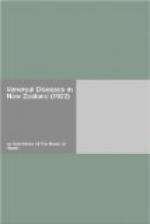This Act secures that individuals of one class of the community—viz., convicted persons—can be held until freed from venereal disease with which they were known or found to be infected. The measure is of value, but logically seems unsound, because the venereal diseases from which such persons suffer are in no way a greater danger to the public than the same diseases in the law-abiding subject of any class, and, furthermore, the Committee have no reason to conclude from the evidence that convicted persons, as a whole, show a higher percentage of venereal cases than those who never enter a prison. The Controller-General of Prisons submitted a schedule showing that the number of prisoners detained under the Prisoners Detention Act from its commencement in 1916 to 1922 was twenty-eight, consisting of nineteen males and nine females.
(E.) Social Hygiene Act, 1917.
In the words of the Commissioner for Public Health of West Australia, who prepared the first comprehensive legislation on venereal diseases in 1915, this Act “can hardly be classed with recent Australian legislation, for the reason that it provides for no notification of the disease and no compulsory examination.” By this Act infected persons are required to consult a medical practitioner and go under treatment by him, or at a hospital; but no penalty is provided, and there is nothing to compel such persons to do either of these things.
Reference to case 1 in the concrete examples cited above will show the weakness of the Act. The waitress continued in employment, handling cups and spoons and cakes, &c. The Medical Officer of Health had every reason to believe she was infected with syphilis, but, not having the power to insist on her obtaining medical advice, he could do nothing to enforce the provisions of section 6 of the Act.
Section 7, making it an offence for any person not being a registered medical practitioner to undertake for payment or other reward the treatment of any venereal disease, has, in the opinion of the Commissioner of Police, proved beneficial in restricting the operation of quacks, but he suggests that it should be amended by deleting the words “for payment or reward,” as it is sometimes easy to prove the treatment and difficult to prove the payment, and it is the treatment by unqualified persons that is aimed at.
Section 8, which makes it an offence knowingly to infect any person with venereal disease, is practically inoperative, as will be shown later in this report, owing to the extreme difficulty, in the absence of any system of notification and compulsory treatment, of proving that the offence was committed knowingly.
The Committee desire to draw attention to section 13. Herein is provided towards hospital maintenance a higher subsidy for venereal patients than is receivable for the maintenance of patients suffering from other infectious diseases. They think that it is inadvisable to particularize venereal sufferers, or, indeed, to draw any distinction between different classes of diseases in a hospital, and that the ordinary subsidy should be paid in all cases.




